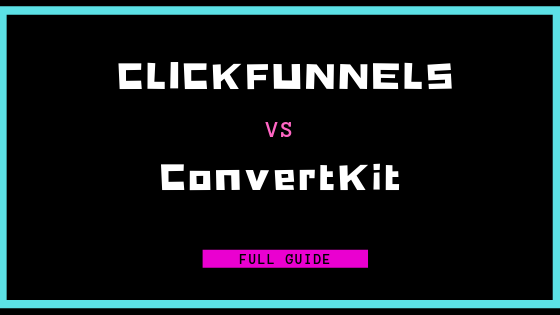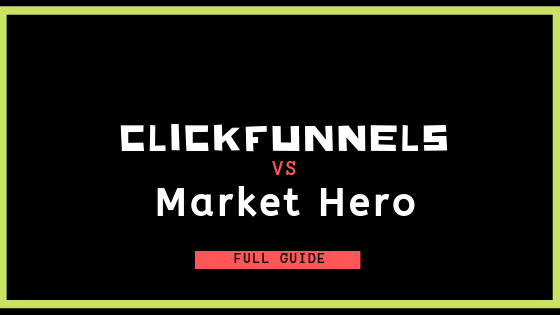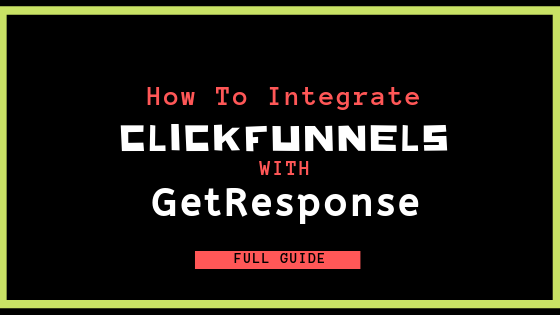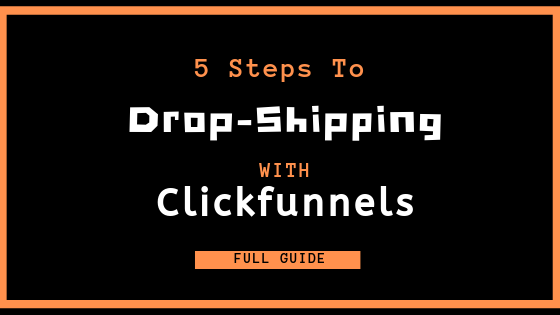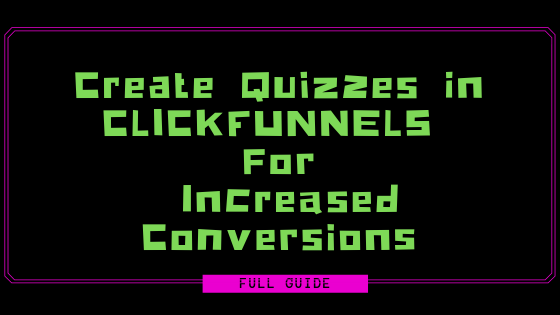ClickFunnels vs. ConvertKit: How Do You Choose?
There are a variety of tools available now to help your company’s marketing efforts, especially online. These tools can help promote your products your services to a broader audience in different ways, from social media ads to newsletter campaigns. However, two popular marketing tools that are benefitting more businesses online are the sales and marketing funnel, and email autoresponders.
Many applications are designed to help companies build their own sales and marketing funnel online, but which ones should you use? Among the more trusted and popular sales funnel and marketing tools include ClickFunnels.
But what about email autoresponders? ConvertKit is ranked as another popular marketing tool for businesses interested in taking advantage of their sales funnels.
But, what’s better for your business’s marketing efforts: ClickFunnels or ConvertKit? Both ClickFunnels and ConvertKit offer similar—as well as their own—set of advantages, including the following:
| ClickFunnels Advantages | ConvertKit Advantages |
| User-Friendly | Cost-Efficient |
| Customization | Variety of Plan Options |
| A/B Testing | Email Segmentation |
| Easy Set-Up | Supports 3rd Party Integration |
| Multiple Templates | eCommerce Compatible |
The best marketing tool for your business will ultimately depend on your business needs and goals.
The following will review both ClickFunnels and ConvertKit—including the types of sales funnels and marketing offered and the benefits they have—so that you and your marketing and sales teams can make an informed decision about which platform is best suited for your needs.
Understanding Online Sales Funnels
Before going into whether or not one sales and marketing funnel builder or the other is right for you, it’s important first to understand what online funnels are and how they can help your business. From there, you can determine what you need out of your sales and marketing funnel to get the most benefit for your company.
Defining Sales & Marketing Funnels
An online sales or marketing funnel is a form of marketing strategy companies use to convert online users into interested prospects and eventually returning customers.
The idea of online sales and marketing funnels comes from what its name refers to—a funnel. At the top of the funnel, toward the wider end, you have your general online audience—or a target market that you want to attract to your business. The goal of the sales and marketing funnel is to channel them through various checkpoints within the funnel (via your website and other marketing efforts) until they reach the bottom; this is when they will want to invest in the products or services you have to offer.
However, not every person who enters your organization’s sales and marketing funnel will end up wanting to purchase your products or services, so how do you get them there?
The key is to use the checkpoints within your funnel. These checkpoints are essentially smaller actionable items or goals for your potential customers (such as subscribing to your newsletter or following you on social media) that make it easier to lead them to the point of purchase. Usually, this is where autoresponders come in—email messages that are sent automatically in response to a user opting-in or filling out a form.
About ClickFunnels & ConvertKit
Trying to decide whether ClickFunnels or ConvertKit offers the best online sales and marketing options for you? The following covers information about each application, their features, and benefits.
ClickFunnels
ClickFunnels is a website application that helps companies build sales funnels for the purpose of marketing, selling, and delivering their products and services online. (Source: Finances Online) It has many features that allow businesses to create highly efficient and effective sales funnel. Read our full Clickfunnels review here.
ClickFunnels Features
- Short Sign Up and Set-Up
- A/B Split Tests
- Free 14-Day Trial
- No Long-Term Contracts
- Free Updates
- Wide Selection of Widgets & Page Elements
- Affiliate Program
- Drag & Drop Web Page Editor
- Smart Shopping Cart
- Email & Facebook Marketing Automation
- User-Friendly Dashboard
- Free Domain Name with SSL Installation
ClickFunnels: How it Works
ClickFunnels can help set up your company’s sales and marketing funnel in just a matter of minutes.
Step 1: Choosing the Funnel
ClickFunnels will guide you in choosing the best type of sales and marketing funnel for your business. The type of sales and marketing funnel you choose will need to depend on your goals. There are three main categories ClickFunnels allows users to pick from:
- Lead Generation
- Generate Sales
- Run an Online Event
There are other special funnels ClickFunnels offers, such as Membership funnels that businesses can choose from as well.
From there, ClickFunnels will offer various funnel subcategories within the category you choose. Each subcategory is more specific to different industries and the types of products and services you may be offering.
ClickFunnels Funnel Options
| Category | Subcategory | Description |
| Lead Generation | Squeeze Page Funnels | Basic email or messenger leads. Use this type of funnel if your goal is to capture email addresses and build a list for future campaigns. |
| Application Funnels | Longer form application leads. These funnels are typically used to acquire detailed information about leads, including name, phone number, email, and more. | |
| Generate Sales | Tripwire Funnels | A two-step “tripwire” or “unboxing” funnel. These funnel types are more commonly used with lower-priced products to gain first-time customers. One-click upsells are later used in the funnel to help generate sales. |
| Video Sales Letter Funnels | These funnels are often used for products that require more of a selling effort, either because the product requires more explanation or a presentation is needed to sell the perceived value of your product. Similar to tripwire funnels, video sales letter funnels use one-click upsells to earn additional sales. | |
| Product Launch Funnels | As the name suggests, launch funnels are used to launch new products and services. These funnels work especially well for expensive products as you are afforded more time to sell people on the perceived value of such products. | |
| Run an Online Event | Webinar Funnels | These funnels are meant for webinars that use third-party applications such as gotowebinar or zoom. The funnels can be customized for the registration process, and also aids in conversion and sales. |
| Auto-webinar Funnels | These funnels are designed for automated, on-demand webinars that can be completely run within the ClickFunnels platform. The funnels are compatible with premade presentations. |
Source: ClickFunnels
Step 2: Editing the Funnel
After selecting the appropriate funnel type for your business, ClickFunnels automatically sets up the pages you need based on the chosen funnel. From there, you can add, move, delete, or edit the pages to make the overall funnel the most relevant to your company’s offerings.
- Adding Pages – ClickFunnels allows you to add
extra pages to help guide potential customers through your funnel. Pages available
to add include:
- One-Click Upsells
- Membership Areas
- Order Forms
- Affiliate Centers
- Editing Pages – Your company’s logo, videos, products and services descriptions, blogs, and more can be added to the ClickFunnels template with a drag and drop function. ClickFunnels’s advanced Etison Editor allows you to customize your pages even more, with a custom CSS option, padding adjustment, and color adjustments.
Step 3: Adding Products
Next, you will have to add your products (both digital and physical products) into your newly developed sales and marketing funnel. The ClickFunnels dashboard has a section where you can add products and their selling price. You can also integrate ShipStation to your funnel so you can make order fulfillment easy for your business.
Step 4: Setting a Domain
After adding your products, you will be required to set up a domain for your new sales funnel so that people can visit it.
Step 5: Save Your Funnel & Start Capturing Leads
Once you’ve finalized your ClickFunnels sales and marketing funnel, it’s time to save it, make it live, and start capturing leads. With ClickFunnels, you can either capture leads automatically (by setting up email messages or short sequences that are triggered by an opt-in or sale) or through an autoresponder, such as Actionetics (ClickFunnels’s in-house autoresponder).
From there, ClickFunnels allows you to build lists for follow-ups or future campaigns.
ClickFunnels Advantages
- Cost-Effective – Other online sales funnel usually require businesses to already have web hosting, landing pages, autoresponders, and more already set up in order to work effectively. Having to invest in all of these different tools can become costly. However, one benefit of ClickFunnels is that the application provides all of these tools in a single package.
- Saves Time – Because all of the tools you need to build your online sales and marketing funnel is in one place, it takes less time to set up. In addition, ClickFunnels’ templates allow you to save time that would be spent building a sales and marketing funnel from scratch.
- User-Friendly – ClickFunnels’ dashboard is
very user-friendly for those new to sales and marketing funnels. Its simplicity
allows businesses to easily integrate their own personalized content within
their funnel, including animation, videos, blogs, and more. The interface also
allows users to test their sales and marketing funnel for its effectiveness.
- Visual Drag & Drop Editor – The visual editor tool makes it easy for users to edit, add, delete, and move elements around a page.
- Easy Set-Up – Setting up your sales and marketing funnel through ClickFunnels can take as little as ten minutes.
- Multiple Sales & Marketing Funnel Templates – ClickFunnels allows you to choose a sales and marketing funnel most
suited for your business from a library of over 30 different templates. They
offer multiple categories and subcategories of templates, including:
- Subscriptions
- Order Forms
- Affiliate Pages
- Webinars
- One Time Offers (OTOs)
- Opt-Ins
- Presales
- Sales Pages
- Thank You Pages
- Split Tests – ClickFunnels offers A/B
split-test functionality so you can efficiently test the effectiveness of your
sales funnel. You can test a number of funnel features, including:
- Headlines
- Videos
- Pages
- Buttons
- Images
- Copy
- Track Stats Easily – The ClickFunnels dashboard displays visual charts that can help you determine which of your funnels are converting the most. In addition, the dashboard is pre-formulated, meaning it will automatically track and generate reports for you as you continue to check.
(Source: ClickFunnels)
ClickFunnels Disadvantages
- Limitations on Funnels & Visitors – ClickFunnels actually limits you to create no more than 20 funnels or 100 pages on their most affordable plan. In addition, businesses on this plan are restricted to 20,000 visitors.
- Steep Learning Curve – Although ClickFunnels has a user-friendly dashboard and provides the resources to ease new users into the application, learning how to use and navigate through the process of creating funnels can still seem quite intimidating.
- Expensive for Small Businesses – ClickFunnels offers two separate plans, the first (standard plan) starting at $97 a month, while the second (etison Suite/premium plan) is at $297 a month.
- Limited Split Testing – Users are limited in which features of their funnel they can test.
ConvertKit
ConvertKit is essentially an email service provider that specializes in content marketing for businesses. It is a popular online marketing tool for bloggers, podcasters, and other creators whose goal is to build their audience.
ConvertKit Features
- 30-Day Refund Policy
- Plans Start at $29/month
- 14-Day Free Trial
- Built-in Split Testing
- Landing Page Builder
- Visual Automation Editor
- Email Segmentation
- Auto Resend Ability
- Supports Teams
- Customizable Opt-in Forms
- Supports Third-Party Integration
ConvertKit: How it Works
ConvertKit can be broken down into five major building blocks in order to work effectively for your business.
Block 1: Forms & Landing Pages
ConvertKit helps you create forms that can help you build your subscriber and email list. They can be embedded on any of your website pages or added as a popup when visitors come to your page.
There are three types of form templates ConvertKit offers:
- Full
- Minimal
- Clean
ConvertKit can also help in building landing pages for your site; there are 18 templates to choose from.
Block 2: Subscribers
Since ConvertKit is tag-based, you only have a single database of subscribers, but you can segment them with the tag functionality. You have complete freedom to segment your subscriber list in any way that works for your business, from their location to when they subscribed.
You can also individually review subscribers and their histories, such as previous emails you have sent them, what sequences they’re on, or even the products they may have previously purchased from your business.
Block 3: Broadcasts
ConvertKit makes it easy for businesses to create one-off emails for their subscribers outside of sequences.
Block 4: Sequences
This is where you can create autoresponders for your audience. You can simultaneously view the different emails within a series while within the email editor. From this dashboard, you can easily change the sequence of various emails, or edit, add or delete them.
Block 5: Automations
ConvertKit’s automations are by far the most important element the application offers. Subscribers can enter ConvertKit automations in four ways:
- Forms
- Tags
- Custom Fields
- Purchases
When a user has triggered an automation, you can add one of three options to complete it:
- Action – Actions include adding a subscriber to an email sequence or autoresponder, adding or removing a tag from a subscriber, setting a custom field, or introducing a delay in scheduled responses.
- Condition – Conditions allow you to branch your automation based on tags or custom fields. For example, maybe your VIP customers take one automation path while non-VIP customers take a different path, even though both sets of customers trigger the same initial automation.
- Event – Events push your subscriber to the next step of an automation (or sales funnel in some cases). For example, one of your new leads in the middle of an automation may decide to purchase a product. In this instance, you may have an “add tag” event in which that user is tagged as a “customer” and then automatically moved to a different email sequence.
ConvertKit Advantages
- User-Friendly – ConvertKit’s interface is very user-friendly. Even those new to applications of this nature can manage the various marketing tools available within the platform in minutes.
- Email Segmentation – ConvertKit’s tagging feature allows you to group subscribers together for easy segmentation.
- Third-Party Integration Support – ConvertKit supports more than 80 third-party applications, including LeadPages and Shopify.
- Compatible with eCommerce – ConvertKit offers features that are e-commerce friendly, such as the ability to track each purchase made by subscribers.
ConvertKit Disadvantages
- Limited Automation – ConvertKit only offers about four triggers in which an advanced automation can be started. Other email autoresponders, in contrast, can have up to 15.
- Lacks Page Tracking – Without these advanced features, it can be hard to determine where users are coming from and where they go throughout your website. In turn, it can be difficult to determine the type of follow up you send them.
- No Lead Scoring or Unsubscribing – ConvertKit does not have a lead scoring or unsubscribing feature that allows you to clean your lists of people who are inactive customers or poor leads.
- Limited A/B Testing – ConvertKit allows you to split test subject lines of email messages, but not for their content, delivery times, or automations.
- Few Customization Options – While ConvertKit’s forms look nice and clean in appearance, there is no way to customize them outside of color. The only way you can customize is through custom CSS, which you will need to take time to pick up if you’re not familiar with it.
- Low Number of Email Templates – ConvertKit does not offer a lot of email templates for businesses wanting to send regular newsletters, but those they do have involve much HTML and CSS work.
Comparing ClickFunnels & ConvertKit
Although both ClickFunnels and ConvertKit have different functionalities, they do share a few similarities, as well.
Similarities Between ClickFunnels & ConvertKit
- Automations – Both ClickFunnels and ConvertKit support automation creation.
- Landing Pages – Both applications allow users to create landing pages based on the templates they provide.
- Split Testing – ClickFunnels and ConvertKit have A/B testing capabilities so that you can determine which features are converting.
- Unlimited Emails – Send unlimited emails no matter which plans you choose for either software.
- Custom Email Templates – Email templates are built to be responsive and customizable for any business.
- WordPress Compatible – ClickFunnels’s pages can be imported to a WordPress website. A WordPress plugin with ConvertKit allows you to add call-to-action forms to posts and pages.
- Variety of Integrations – Both applications can integrate with over 20 third-party applications, including eCommerce tools, membership platforms, and more.
- No Contracts – ClickFunnels and ConvertKit offer free trials, and no contract is required to sign up.
Differences Between ClickFunnels & ConvertKit
- Pricing – ConvertKit is significantly cheaper than ClickFunnels, with plans ranging from $29 to $79 a month (0-5,000 subscribers). ClickFunnels, by contrast, offers plans at $97 and $297 a month.
- Overall Functionality – ConvertKit usually appeals to bloggers, YouTubers, and other types of creators who want to build their audience online. ClickFunnels is more of a packaged sales and marketing software for different types of businesses, especially those in e-commerce.
- Webinar Functionality – While ClickFunnels fully supports webinar funnels (including the hosting) and the automations for them, ConvertKit is limited to only manually scheduled emails via Broadcasts.
However, the most significant difference between ClickFunnels and ConvertKit is that they both technically serve different roles. ClickFunnels is designed to be more of a sales funnel builder and manager, while ConvertKit more so an email service provider.
The following table from Gedlynk offers a more detailed comparison chart for ClickFunnels and ConvertKit:
| Feature | ClickFunnels | ConvertKit |
| Designed For | Designed for professional marketers and entrepreneurs in need of a complete sales and marketing funnel system. | Designed for bloggers, content marketers, and small businesses with an online presence. |
| Cost-Effectiveness | Cost-efficient for the all-in-one marketing tools you get. | Much cheaper compared to other email provider services and marketing tools. |
| Set-Up Time | The ClickFunnels dashboard and templates allow you to build your online sales and marketing funnel quickly. | Takes little time to set up. Get started running your first campaigns in minutes. |
| Templates | ClickFunnels allows much room for customization, offering over 30 templates to choose from. | Choose from a small selection of templates. |
| Split Testing | ClickFunnels lets you test the effectiveness of your sales funnel’s features (image, content, headline, etc.) through A/B testing. | Test the subject lines of emails through A/B testing. |
| User-Friendly | The ClickFunnels’ dashboard is easy-to-use, both for professional marketers and those new to digital marketing. | Easy to navigate for both tech-savvy and non-tech-savvy users. |
| Reports | Keep track of the status of your traffic and subscribers through the dashboard’s simplified visual reports. | Get detailed reports of each email that is sent out as well as your subscriber’s history with your business. |
| Perks & Additions | Receive a free domain name with included SSL with a new ClickFunnels account. | N/A |
| Contracts | No contracts. Plans can be applied as a month to month or yearly basis. Cancel at any time. | No contracts. Plans can be applied as a month to month or yearly basis. Cancel at any time. |
| Trial Periods | Free 14-day trial before you commit. | Free 14-day trial before you commit. |
| Updates | Regular updates to the dashboard and funnel system, free of charge. | Few free updates. |
| Email Marketing Automation | Automations based on position in sales and marketing funnel. Unlimited automation funnels in premium plan. | Automation is based on a series of triggers, such as opt-ins and form completion. Unlimited automation rules on all plans. |
| Contacts | Unlimited contacts on all plans. | Up to 1,000 contacts on the most affordable plan. Plans available for up to 9,000 contacts. |
| Teams | N/A | Supports multiple users within a team. |
| Email Courses | Unlimited autoresponder series in premium plan. | Unlimited email courses on all plans. |
| Support | Personalized support through email and chat formats, in addition to support resources online. | Personalized email support and concierge service for new users. |
Source: Gedlynk
Which Application is Best for Your Business?
Both ClickFunnels and ConvertKit can equally help your business’s marketing in their own ways. ClickFunnels allows companies to create a sales and marketing funnel to eventually generate leads and sales, while ConvertKit can help build your online audience and promote your products.
In some ways, you could use both applications to market your business; however, each platform works best on its own. Take some time to review ClickFunnels and ConvertKit with your sales and marketing team to determine which offers more of what you need for the company. If needed, sign up for the free trials for both applications at different times to see which works best with your current sales and marketing strategies.
Once you’ve chosen the appropriate application for your business, get set up as soon as possible; the sooner you start, the sooner you start generating those leads and sales you’ve been after!
